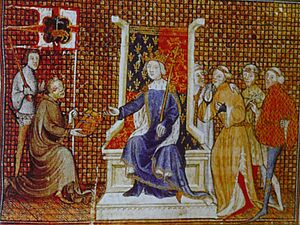Philippe de Mézières facts for kids
Philippe de Mézières (born around 1327, died 1405) was a brave French soldier and a talented author. He was born in a castle called Mézières in a region of France called Picardy. Philippe spent his life trying to make the world a better place, especially by dreaming up a new group of knights to protect important places.
A Young Soldier's Adventures (1344–1358)
Philippe came from a less wealthy noble family in France. He started his career as a soldier, first working for Luchino Visconti in Lombardy. Soon after, he joined the service of Andrew, the Duke of Calabria, who was married to Queen Joanna I of Naples. Sadly, Duke Andrew was killed in 1345.
Later that year, Philippe joined the French army and traveled to the East. After a battle in Smyrna in 1346, he was made a knight. When the French army broke up, he journeyed to Jerusalem. There, he noticed how well-organized the Saracen armies were compared to the Western armies. This gave him an idea: he wanted to create a new, disciplined group of knights. He even wrote down his ideas for this new order, called the Nova religio passionis, in 1367.
In 1347, Philippe went to Cyprus and met King Hugh IV. He also met the king's son, Peter of Lusignan, who shared his passion for crusades. Philippe left Cyprus for a while and worked as a mercenary (a soldier who fights for money). But when Peter became King of Cyprus in 1358, Philippe returned, probably in 1360, and became the king's chancellor.
Life in Cyprus and Crusades (1360–1372)
While in Cyprus, Philippe became good friends with a religious leader named Peter Thomas. Peter Thomas was a big supporter of a new crusade, a holy war to take back lands in the East. In 1362, King Peter of Cyprus, along with Peter Thomas and Philippe, traveled across Europe. They tried to get support for this new crusade.
When King Peter returned to the East, he left Philippe and Peter Thomas to ask for help in Avignon (where the Pope lived at the time) and in Italian cities. They encouraged people to join the crusade in Germany. Philippe then went with King Peter to Alexandria. After they captured the city, Philippe was put in charge of part of it. He was also promised that his new order of knights would be created. However, the crusaders were happy with the treasures they found and didn't want to continue fighting.
In 1366, Philippe was sent to Venice and Avignon again. He tried to get help for Cyprus, which was now being threatened by the Saracens. But his efforts failed. Even Pope Urban V suggested making peace. Philippe stayed in Avignon for some time, still trying to find people to join his knightly order. He also wrote a book about his friend, Peter Thomas, which is important for understanding the Alexandria crusade.
Philippe returned to Cyprus in 1368. But while he was in Venice, King Peter was killed in 1369. Philippe stayed in Venice until 1372, then went to the new Pope, Gregory XI, in Avignon. He worked to establish a special religious holiday, the Feast of the Presentation of the Virgin, in Western Europe.
Advisor in Paris (1373–1405)
By 1373, Philippe was in Paris. He became a trusted advisor to King Charles V of France, even though the king didn't want to join a crusade. Philippe even taught the king's son, who would become King Charles VI. After King Charles V died, Philippe, like other advisors, had to retire from his official duties.
Philippe then lived in a monastery in Paris called the Celestines. But he still had influence in public matters. He was close to Louis of Orleans, which led to some people spreading rumors about him. When King Charles VI took more control of his kingdom, Philippe's influence grew again. Philippe supported Pope Clement VII during a time when there were two popes, known as the Great Schism.
Most of Philippe's writings come from this period. He wrote two religious books, Contemplatio horae mortis and Soliloquuum peccatoris, around 1386–1387. In 1389, he wrote his Songe du Vieil Pèlerin (Dream of the Old Pilgrim). This was a long story where he described different places in Europe and the Middle East. In it, he argued for peace with England and for continuing the crusades to take back the Holy Land. His Oratio tragedica, which included parts of his own life story, had similar goals.
In 1395, he wrote a letter to Richard II of England, encouraging him to marry Isabella of Valois and make peace with France. He also urged him to join a new crusade against the Turkish armies. However, Richard did not join. Only French forces helped the King of Hungary, Sigismund. Sadly, the French forces didn't follow the king's plans and were defeated in the Battle of Nicopolis. This disaster proved Philippe's fears were right. It also led to his last work, the Epistre lamentable el consolatoire, where he again suggested his knightly order as a way to prevent future problems.
Some of Philippe's letters were printed in a history magazine. Two of his letters were also included in a famous book called Froissart's Chronicles. Another book, Songe du vergier, written around 1376, is sometimes thought to be his, but there's no clear proof.


